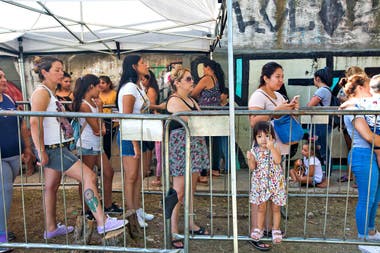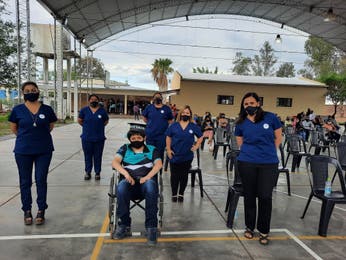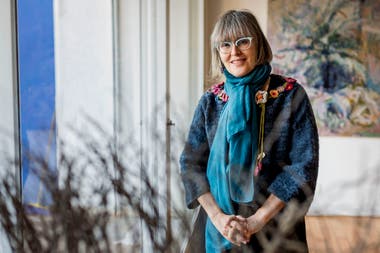The outlook could not be more challenging. After being ratified in their positions in February, the Ombudsman for Children and Adolescents (NNyA), Marisa Graham, and her two deputies, Facundo Hernández and Fabián Repetto, have before them
an extremely complex task exacerbated by the context of the pandemic
.
How is COVID-19 changing the agenda for children and adolescents? What will be the impact of quarantine on the youngest in the medium and long term? In dialogue with LA NACION through a video call -the means in which the defenders are channeling the cataract of meetings that they have these days-, Graham, Hernández and Repetto emphasize that the social isolation by the coronavirus put crudely on the table long-haul structural problems, from the
hungry
up to
inequality
in accessing a
decent housing
and to basic services like
Water
. But, in addition, it brought with it “a tsunami” -as Graham calls it-, which deepened other violations of rights linked to the situation.
With his appointment, he began to pay off a debt to children that had been going on for more than a decade: the position that Graham occupies today was created in 2005 by law 26.061 on comprehensive protection of children, but had never been filled.
-For many minors, their homes are far from being the safest place during the quarantine and they were much more vulnerable to atrocious violence such as sexual abuse. How can it be prevented?
-Graham:
Although there are people who do not like to talk about worse forms of mistreatment of children and adolescents, and it is fine because violence is violence, we must clarify that there are everyday microviolences and from there others that go as far as sexual abuse childish. They do not have the same treatment. Microviolence is ill-treatment that is not perceived as such by the majority of the population. For example, when fathers, mothers or at school use corporal punishment with the excuse of “correction or education” of boys and girls: the chirlo, the zamarreo, humiliating them by sending them to the corner in front of their classmates or insulting teenagers. We have to work hard on that because the non-registration of that violence then generates the overflows that lead to the most atrocious and sinister crimes, which I call cruelty to boys and girls.
-Is registering those microviolences a first step?
-Graham:
If I do not register that my son or daughter is a subject, an other equal to me that I must respect and that I cannot subjugate their bodies, it is more likely that other violations will be generated later. The only way to promote and prevent the most atrocious violence has to do with raising awareness that adult bodies cannot overwhelm those of boys and girls. Parents should be made aware of and emphasize good treatment, because when it comes to violence in general people think of a boy or girl brutally beaten or sexually abused, and most dads or moms luckily they don’t identify with it, but they don’t see their own violence against children either.
-In this context, without the presence of the school and with very limited health services, sexual abuse is even more in the shadows.
-Graham:
The issue of child sexual abuse is a complex issue, closely associated with violence against women. We know that the aggressors have a modus operandi that is the isolation of their victims. If we add compulsory isolation to that, it is fertile ground for these violations to deepen.
-I repeat:
In the absence of the primary care center or the school, the natural institutional detectors are in short-term retraction. Community organizations play an important role there. We have been thinking strongly about the role they can have, albeit in a more artisanal way, in detecting this type of situation, for example, community kitchens. It is necessary to mobilize the social fabric that is sensitized on the subject but that does not have the instruments for early detection such as educational or health protocols. The community role is fundamental not only in the emergency, but also in the future. When everything returns to “normality” it is essential that the existing mechanisms can be monitored and improved, and from the defense we will be very vigilant, because obviously everything was not right until the school closed or the health center did not attend, but that there was a pending subject.
-For a few years, sexual abuse against boys and girls has been a crime of public action, which implies that we all can and must denounce. What awareness is there at a social level about this duty?
-Graham:
This question ten years ago was not possible. The issue made great progress with the Ni Una Menos movement, but also since 2005 with the law for the comprehensive protection of the rights of children and adolescents. What happens is that our country lives in an eternal
corsi and ricorsi.
Sometimes we are better and sometimes we go backwards. There is still a long way to go, but it is also necessary to recognize that we have traveled a lot.
-Hernández:
We must remember that until 2015 the Civil Code allowed physical punishment and humiliating treatment of boys and girls. There was a worldwide movement to eliminate that.
-Graham:
Admittedly, we were one of the few countries that did not have a rule that expressly prohibited corporal punishment. That year, in Argentina we repealed the article of the code that allowed parents to exercise the duty of correction “in a moderate way”, which was very subjective. We introduce a rule that expressly prohibits physical abuse and in general towards boys and girls for the sake of their education and upbringing.
-During quarantine, the time that boys and girls spend on screens grew and so did the alert for dangers linked to social networks, such as grooming. How to decrease the risks?
-Hernández:
There is a consensus on the need to create a route for protecting rights on the Internet. But before that, you have to work hard on what is digital literacy and prevention, understanding that networks have wonderful things (in fact, they are now an alternative education mechanism to face-to-face), but that they also carry dangers. It is important that mothers and fathers understand this, without generating fear, but being vigilant. Regarding the protection route, it is essential that there is a coordination of the different actors that work in the prosecution of crimes. In the city of Buenos Aires, specialized prosecutors are very good and it would be important for them to be available throughout the country. On the other hand, it is key not only to find the person responsible for this violation of rights, but also to take into account that behind the complaints there are boys and girls who, as victims, require very important accompaniment in the courts and should not be re-victimized.
-In the implementation of Comprehensive Sex Education (ESI) there were also advances, but there are still many disparities between the provinces and within each one. Will guaranteeing this right be a priority?
-I repeat:
Definitely. But I would put a bigger frame on it. There is a need for the provincial and municipal states to take comprehensive approaches to adolescence seriously, which has a lot of unresolved issues from the point of view of public policies: the educational terminality of secondary education is a very emblematic example, thus like problematic consumption. Sexual and reproductive health is part of the family of these problems. The pending subjects at ESI are huge. There is a lot of work to be done in all age groups and with different actors in public policy, for example in early education and in early childhood settings, where there are more than 100,000 boys and girls. If we do not have common ESI approaches from then until adolescence, we will have very dramatic consequences.
– The greatest challenge will be to reach agreements between the provinces regarding its implementation?
-I repeat:
We are going to have to make many efforts of political, technical and institutional conversation with the provinces: in some, the pending subjects are very evident and sometimes it happens that the problem is not at the level of the government but with the effector, since those responsible for the In some cases, the educational system keeps the materials that come from the National Ministry of Education in the drawer. The ombudsman’s office is going to have to deploy its territorial alliances to fight for this not to happen.
-The 102 NNyA free helpline has an increasingly widespread presence throughout the country. However, some provinces still do not have it. Is it going to work to implement other care channels that are more accessible to boys and girls?
-Hernández:
We are permanently having meetings with different civil society networks and we have already met with a hundred organizations virtually. What we hear from several is that with 102 it is not enough. We must provide the line, on the one hand, with more services than what is behind. As an advocate, we made a request that all childcare services be declared essential. The novelty is to generate accessible mechanisms for boys or girls: 102 children do not call. You have to access in another way. We are working with the provincial defenders strongly to think innovative proposals. Another topic that we discuss a lot is the importance of alerting the population, because as the smallest girls and boys have no voice, or even adolescents in the state of defenselessness who are in the situation of abuse or mistreatment, there must be others that they can make that complaint, those who are physically closer and can get to listen or suspect. They have a responsibility to report.
-Graham:
We appeal to society, to the entire adult world. What we say is: “he and she cannot report because they have their aggressor by their side, but you who listen or know, yes.” Because in the building, you know; in the town, it is known. Many times it is known. Whoever has the data, please denounce and know that the NNyA are in a situation of absolute helplessness and very afraid, because they are living with their aggressor permanently.
-What will be the main challenges that the pandemic and the quarantine will leave regarding the violation of the rights of the NNyA?
-Graham:
The pandemic generated as a kind of tsunami. There are very structural problems and others that are deepening. The issue of decent housing is one of the debts of democracy. We have not managed to solve it, neither in the city of Buenos Aires, the richest district in Argentina, nor in the province, nor in many of the jurisdictions with greater or lesser budgets. What COVID-19 did was put on the table structural deficits that we have been dragging: what is happening today in the villas has to do with not having been able to settle the issue of decent housing and that we have popular sectors that continue to live in the overcrowding, without light, without water. The issue of housing must be resolved as one of the rights of the NNyA. With regard to the villas, especially in this moment of pandemic, we urge that the conjunctural issues be resolved as soon as possible.
-I repeat:
The tsunami effect of the pandemic that Marisa talks about makes inequality very evident, in addition to those structural issues such as housing. It turned white on black the huge inequalities not only in income but also in access to the Internet and the cultural capital of households, for example. We are working on a document on the day after and outlining a kind of decalogue of fundamental issues that were present, but are currently being sharpened. In this context of inequality, a strong role of the ombudsman is linked to the issue of the budget, not only national but provincial. Approximately three quarters of the investment made in childhood and adolescence are provincial budgets and, to a lesser extent, municipal budgets, which is why we have a very strong monitoring task there. September will be a budget closely associated with the reconstruction of how the necessary resources are shielded so that the rights of the NNyAs are strengthened and strengthened, in a context that, of course, is going to be of many fiscal constraints.
-Hernández:
One of our priorities will be what we call the re-hierarchization or strengthening of the system of integral protection of rights, which is this set of federal, national, provincial and municipal institutions, which on the one hand attend to the specific cases of violated children but also have all the work of promotion and articulation with other great effectors such as health or education. Many times the protection system is forgotten, and more than ever it will have to have a prominent role. Everything indicates that the return to class is going to be staggered and we know that school is a transmission and contact channel between the State and the children, where we often find out about a lot of things that happen within the family. There will be a very strong debate on the protection system regarding how this whole return to school will be accompanied.
-Deaths from malnutrition of boys and girls in the north of the country were high on the agenda during the summer, but the risk is that the issue will again be forgotten. Will it be a priority for you?
-Hernández:
Before and during the pandemic we had several meetings with the Inter-American Commission on Human Rights. We are collecting information from the most affected populations to see how state interventions are evolving, knowing that it is a structural and complex problem. We also had two virtual meetings with authorities from the province of Salta and it is an issue that will surely take us a long time.
–
Graham:
Hunger was the main theme of our three work plans when we participated in the contest to assume the position of defender. For us, it was a priority before the pandemic, which what it did was exacerbate the problem of the food emergency. We have great appreciation for the efforts that have been made from the National and Provincial Governments with the Food Card and the Emergency Family Income, for example. But surely, beyond this, we will have more problems in relation to NNyA with hunger, not to mention in sectors that already suffered from it, such as the indigenous peoples. In addition, we will surely have greater malnutrition, a problem that cuts across all social strata.
-I repeat:
The challenge of the ombudsman’s office is to be very capable of dialoguing and controlling what the State does at different levels regarding public policies to deal with the immediate consequences that a noodle and flour pandemic will have. We have planned meetings with different specialists on this topic, for a nutritional continence plan that must be done with multiple edges for the day after. Malnutrition in Argentina is as structural an issue as housing. Although of course the most vulnerable sectors require priority attention, as an advocacy we set out to work on issues that cross all social sectors and malnutrition is one of them.
ALSO

.
Publicado en el diario La Nación




